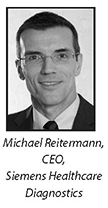"Test smarter, run faster.” That was the motto of Siemens Healthcare Diagnostics (Tarrytown, N.Y.) at the American Association for Clinical Chemistry and American Society for Clinical Laboratory Science 2013 Annual Meeting and Clinical Lab Expo, held July 28-Aug. 1 in Houston.
DTTR sat down with CEO Michael Reitermann to get his view of the marketplace, the company’s latest platform, and how smarts and speed square with emerging technologies.
What macro trends are you observing in the diagnostics industry?
On a global scale, among the inherent growth drivers for our business are demographics and the aging population. From our perspective, these will continue to create a favorable climate for our industry. Then there are different trends when we look at the United States. There is huge pressure on the health care system, and one of the manifestations of that is the pressure on reimbursement.
How do you see the implementation of the Affordable Care Act affecting the diagnostics space?
I associate the [Affordable] Care Act with moving from a pay-per-procedure to a pay-per-insured-life perspective—or population-based insurance—and that has certain impacts on our industry. I believe that, hopefully, it will be a positive impact, because now diagnostic testing and early detection is much more in the interest of the stakeholders.
Here at AACC, Siemens has launched the VersaCell X3. What new capabilities does this new automated platform offer?
The VersaCell X3 is an evolution. We have more variety, more flexibility with the systems that you can attach to it. We have improved the functionality. The new one-touch interface is much easier to use . . . because we also hear that there is a huge demand for experienced lab technicians. And these improvements make it easier for somebody to ease into the profession. Last but not least, you can connect it to our CentraLink [data management system], from the middleware, which allows you to intelligently communicate and direct the traffic in the lab. I’m optimistic that this will bring automation to a new segment and will allow smaller labs—or large labs that want to use it for specialty testing—to think differently about automation.
What is driving the growth within Siemens’ Laboratory Diagnostics business?
New immunoassays are a big growth driver—one of them being vitamin D, which in the last two years has been a great addition to the assay portfolio. Point-of-care is one of the interesting growth opportunities, because in that field, when you look at the trends from a care provision perspective, there is a priority to keep patients out of the hospital, or when they come in the hospital, to quickly make decisions as to whether they need to be admitted. Take the example of chest pain, where a fast troponin test in the ER can help clinicians make critical decisions based on facts. And this is where our point-of-care portfolio can make a difference.
Siemens Healthcare recently announced a companion diagnostics partnership with Johnson & Johnson unit Janssen Pharmaceutica. Is this an area that you plan to continue expanding?
Drugs are getting more expensive and are becoming more targeted, so I believe the area of companion diagnostics will continue to develop. We have three partnerships announced and are working with other players that we will announce partnerships with at the right point in time. It’s also a great opportunity also to expand our assay menu. And the platforms on which those assays will be delivered—whether it’s kPCR, NGS, immunoassays—will depend on what platform is most suitable for the different endeavors.
Associated Data

